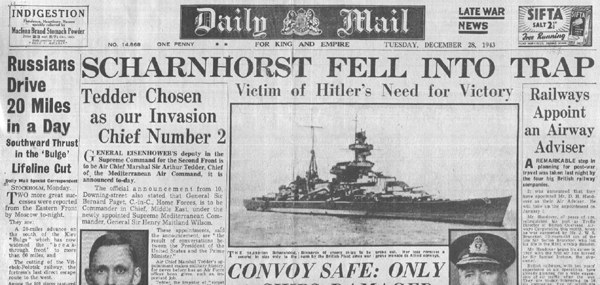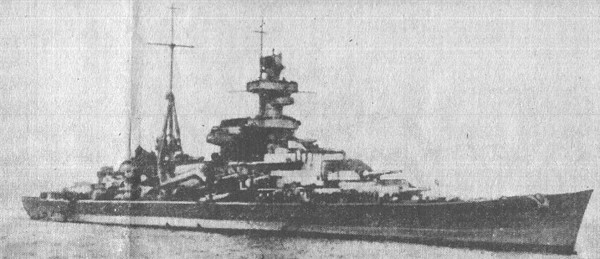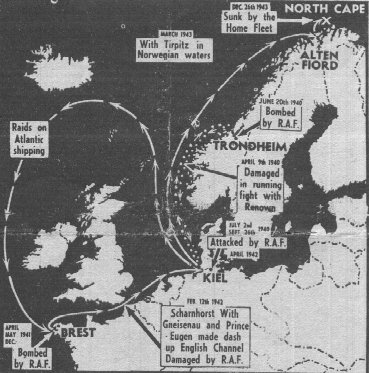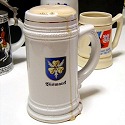


THE 26,000-tons German battleship Scharnhorst, sunk on December 26, fell into a trap set by units of the British Home Fleet. This last of Hitler's capital ships in commission was risked in action because the Germans are in desperate need of a propaganda victory at sea. Outlines of the picture of the battle in the Arctic twilight became clear last night. They show that the British ships, covering a North Russian convoy, were "trailing their coats" for the enemy. An Admiralty communiqué stated late last night that the convoy was unmolested and that only minor damage was sustained by two of H.M. ships. The Scharnhorst was sent to the bottom off north Norway within a few hours' steaming of her base in Alten Fiord.
 ENCIRCLED
"Several days ago an enemy convoy bound for Murmansk had been observed by German reconnaissance aircraft. This convoy carried war equipment and food supplies for the Russian front. A task force of the German Navy was therefore sent against it, and off the North Cape the enemy convoy was intercepted. Poor weather allowed only limited visibility. On December 26 towards 11 a.m. the battle-cruiser Scharnhorst with the commander of destroyers, Konter-Admiral (Rear Admiral) Bey, as C.-in-C. of the task force on board, established fighting contact with escort units consisting of destroyers and cruisers protecting the convoy. Shortly after the engagement had begun one of the enemy heavy units intervened in the battle. In the course of the engagement the enemy succeeded by a surprise move which, owing to the prevailing poor visibility, could not at first be discerned, in bringing up heavy units. After several hours of the fiercest action the Scharnhorst, under the command of Capt. Hintze, was encircled by enemy units. She sank with her colours flying towards 7.30 p.m., after having inflicted heavy damage upon the enemy. The remaining German units participating in the battle suffered no loss." MISCALCULATED The Scharnhorst had been lying in Alten Fiord with the damaged Tirpitz for nearly two years. That she should have gone out alone is a clear indication that the Germans are in desperate need of a propaganda victory in the fleet. Morale has been steadily declining, so that last September a spectacular "raid" had to be made on Spitzbergen, defended by 100 Norwegians, mostly meteorologists. Scharhorst, Tirpitz, and Lützow with a destroyer screen, undertook this "daring exploit." The sunk warship had nine 11in. guns and a speed of 32 knots. No ship of 11in. guns could have answered the 14in. guns o a ship of the King George V class, which was probably Admiral Sir Bruce Fraser's flagships, without taking great punishment. The small pinpoints of fire, glowing as the Arctic twilight faded into night, must have been the forerunners of great flames ravaging the German warship from stem to stern [At this point the article continues on page 4, Col. 1 under the title: "Sunk in Navy's Trap"]
and making her a target that stood out in the darkness. The Scharnhorst probably died with a final explosion of her main magazines, by which she was riven out of all semblance of a ship. If she could have profited by the Arctic nigh to get in among our Russian convoy she might well have done considerable havoc and got clear away. Only our fastest ships could have pursued her, and in doing so she probably calculated that one or more might lay herself open to a lucky torpedo attack from her screening destroyers. But she apparently fell into her own trap and Admiral Sir Bruce Fraser, known for his aggressive tactics, found an occasion worthy of his metal. Three times already he has taken out his ships to "trail their coats" round Alten Fiord. At last his perseverance has had its reward. The question is: Why did the Scharnhorst, with her speed, stay to match herself against the giants of the Home Fleet? The answer is that she must have been crippled and unable to fly. These were the tactics which led to the end of the Bismarck. Our now historic tactics of massed torpedo attacks by destroyers probably got home some good shots. One recalls how the Norfolk and Suffolk dogged the Bismarck in the Denmark Strait. It may well be that cruisers of this type -or even one of these well-tested veterans- skirmishing wide of the main body of the convoy and its escorting units, flashed back the original signal of a German capital ship at sea -the first sight of one, in fact, since that memorable day nearly two years ago when the Bismarck was pinpointed on the chart. In the circumstance one may expect survivors. German ships are over-manned by our standards, and her complement if probably 1,200. Out of such a number a score or more might easily have dodged death both in the ship and in the icy waters to which the flames drove them. With the Tirpitz and Gneisenau damaged, and the Bismarck and Scharnhorst sunk, the only German heavy units capable of action are two 10,000-tons pocket battleships, the Lützow -formerly the Deutschland- and the Admiral Scheer, both of which are in the Baltic. MOSCOW PRAISE MOSCOW radio, praising the "splendid British Navy," last night hailed the Scharnhorst sinking as a "nice Christmas present for the Allies and another portend of dismay for the German people." Russian provincial papers will today prominently feature the full text of the British Admiralty's communiqué. Washington naval observers believe that the loss of the battleship may force the German battle fleet back to its hide-outs for the duration. The German people were told of the loss in the first morning broadcast of German radio yesterday.
|
 BOOK: The Battleship Bismarck. The Complete History of the Ship.
 Naval and military gifts
|

